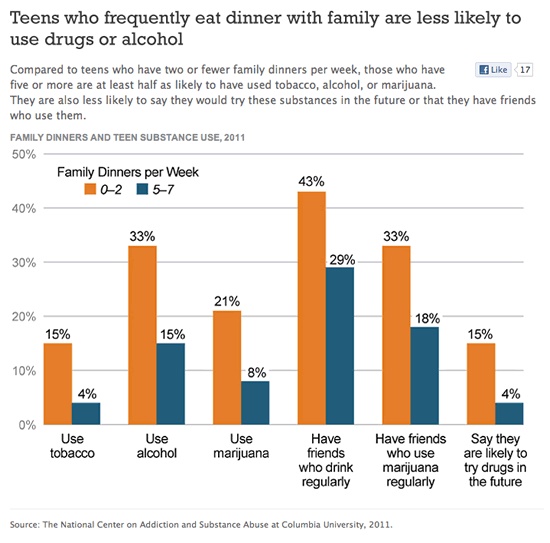- Calls to this hotline are currently being directed to Within Health or Eating Disorder Solutions
- Representatives are standing by 24/7 to help answer your questions
- All calls are confidential and HIPAA compliant
- There is no obligation or cost to call
- Eating Disorder Hope does not receive any commissions or fees dependent upon which provider you select
- Additional treatment providers are located on our directory or samhsa.gov
Dinner Time Do’s and Don’ts
Contributor: Leigh Bell, writer for A Center for Eating Disorders

When families eat together three or more times a week, there kids are:
- 35 percent less likely to develop disordered eating, like bingeing-and-purging, restricting, using laxatives, or smoking cigarettes to lose weight.
- 20 percent less likely to eat unhealthy foods; and 24 percent more likely to eat healthy food.
- 12 percent less like likely to be overweight.
Studies show frequent family meals can improve a child’s vocabulary, mood, academic success, and outlook on the future; and decrease his or her proclivity for behavioral problems.
The Detriments of Not Eating with Family
Teenagers who eat with family five times a week or more have better relationships with their parents and are less likely to smoke, drink, and do drugs. Their peers who have two or fewer family meals per week are:
- Four times more likely to smoke.
- Twice as likely to drink.
- Two-and-a-half times more likely to use marijuana.
So, why aren’t more families gathering around the table? Because it’s hard.
Why Families Aren’t Eating Together
The vast majority of moms work outside the home, and more than 30 percent of families today are single-parent ones, according to the U.S. Bureau of Labor Statistics and the U.S. Census Bureau.
This means moms and/or dads have to throw together a meal right after a long workday. And only if they’ve had time to grocery shop. Add on homework — even for kindergarteners, these days — to the growing number of kids’ after-school activities, and each family has two fistfuls of real reasons to drive-thru for dinner.
Logistics aside, have you ever eating dinner with table full of kids? It’s not exactly relaxing.
The Stress of Eating with Kids

Eating with kids can be stressful, and while dinners are important, parents must give themselves grace. Meals don’t have be magnificent or even great — just often. The more meals together, the easier they become. Everyone gets into the routine, and heaven forbid, even teenagers start to like it. One study found 84 percent of teens prefer to eat with family.
Most research around family meals focuses on the frequency, not which elements of eating together are the beneficial ones. Yet, when family dinners aren’t contentious and include healthy conversation, they foster communication and trust between children and their parents, leading kids to talk about touchier topics like sex, drinking and drugs, and body image.
The Do’s and Don’ts to Improve Family Mealtime
Here are some other tips to make the most of family meals :
DO focus on the meal and each other. Talk about fun and happy things.
DON’T watch TV or use phones, iPads, etc. during dinner.
DO try to schedule meals so everyone knows to be there and younger children learn a structure for eating.
DON’T be too rigid with a schedule. If your child is hungry, allow a healthy snack. It’s important to let kids recognize when they’re hungry or full.
DO allow kids to help plans the meals, including each one’s favorites.
DON’T allow children to have different food because they don’t like the prepared meal.
DO the best you can to make meals stress-free and positive.
DON’T argue during mealtimes. Conflict while eating could teach children unhealthy attitudes toward food.

DON’T lecture your child on the importance of this food or force your child to eat it.
DO allow sweets in moderation, without placing judgment on the food type.
DON’T reward with sweets or give children a sweet when they are sad or upset. This places unhealthy emphasis on sweets and can lead to overeating.
DO have healthy attitudes and behaviors toward food — your child learns from and copies what you do.
DON’T allow yucky faces or negative comments about foods.
DO offer a variety of foods.
DON’T make any food, like candy or sweets, completely off-limits. Kids will give power to the banned food and might eat it despite feeling full, possibly leading to a habit of overeating.
DO encourage children to “listen” to their own fullness cues and allow them to stop eating when they feel full — even if you think they’re not. This fosters independence and weight maintenance.
DON’T reward a clean plate. Your child should stop eating when he or she is full, rather than when the plate is clean.
DO serve food you feel good about your children eating.
DON’T restrict a child’s food during a meal. Statistics associate this with increased eating and obesity.
Community Discussion – Share your thoughts here!
What are some tips you can share for encouraging a healthy dinner time experience?
References:
- Hammons, A. and Fiese, B. (2011). Is Frequency Of Shared Family Meals Related To The Nutritional Health Of Children And Adolescents? Pediatrics, 127(6), E1565-E1574.
- Snow, C. E. and Beals, D. E. (2006), Mealtime talk that supports literacy development. New Directions for Child and Adolescent Development, 2006(111), 51–66.
- Hofferth, S., & Sandberg, J. (2011). How American Children Spend Their Time. Journal of Marriage and Family, 63(2), 295-308.
- The National Center on Addiction and Substance Abuse at Columbia University. 2012. “Family dinners and teen substance abuse. http://www.casacolumbia.org/addiction-research/reports/importance-of-family-dinners-2012
- Skeer, M. (2012, May 22). Does eating meals together as a family steer kids away from risky behaviors? Retrieved February 28, 2015.
- U.S. Department of Agriculture. (n.d.). Health and nutrition information for preschoolers: Develop healthy eating habits. Retrieved February 28, 2015.
- Faith, M. S., Scanlon, K. S., Birch, L. L., Francis, L. A. and Sherry, B. (2004), Parent-Child Feeding Strategies and Their Relationships to Child Eating and Weight Status. Obesity Research, 12: 1711–1722.
Eating Disorder Hope is Pro Family and gratefully acknowledges all the loving and supportive families that help eating disorder sufferers find healing and recovery.
It is not the fault of the family that an individual develops an eating disorder. Eating disorders are complex and developed through a combination of genetics and environment. Trauma can be an environmental factor that contributes to the underlying issues beneath an eating disorder, as can genetic predisposition toward anxiety, depression, and other personality factors.
Ongoing research is being conducted and greater understanding of eating disorders will further enlighten us over the months and years to come.
The opinions and views of our guest contributors are shared to provide a broad perspective of eating disorders. These are not necessarily the views of Eating Disorder Hope, but an effort to offer discussion of various issues by different concerned individuals.
Last Updated & Reviewed By: Jacquelyn Ekern, MS, LPC on March 13th, 2015
Published on EatingDisorderHope.com

